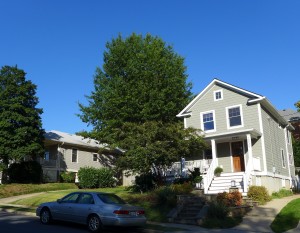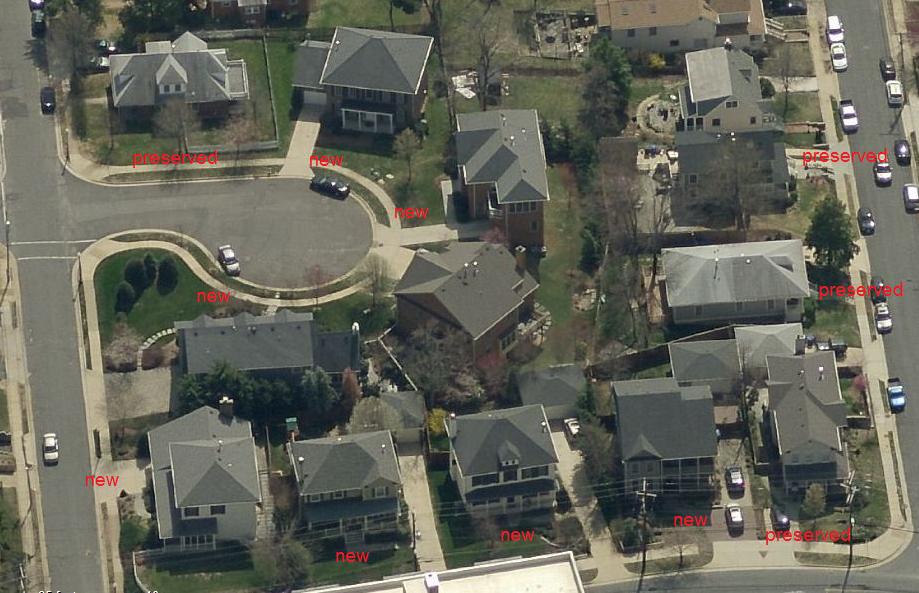Preserved & Developed: Saving a Fab Four in Cherrydale
Preserved & Developed is a weekly series of articles by Preservation Arlington highlighting local development projects that have involved both development of a site and preservation of historic resources. The projects highlight a wide range of challenges and solutions over many years. At the time they were completed the projects represented a commitment by the developer and the community to embrace the future and preserve the past. Preservation Arlington is awarding each project a gold, silver, or bronze star based on the extent to which the project protected historic resources within its particular constraints. 
Acquiring nearly two acres of land in North Arlington — much less in Cherrydale, one of Arlington’s coveted National Register neighborhoods — is a significant purchase. It is not an opportunity that presents itself often and not only requires careful financial consideration but also an awareness of community interests and involvement. This collection of nine properties along Lee Highway between North Stafford and North Taylor street were originally purchased as a speculative land assemblage back in the 1950s in response to high-rise development occurring in the adjacent land between Lee Highway and Old Dominion Drive. 
During the townhouse development booms of the 1980s and 90s, multiple developers looked at the site. Since it was zoned R-6 (single family lots of 6,000 sf minimum), these proposals would have required a combination of rezoning, comprehensive plan amendment, and/or site plan process (a complex entitlement process involving negotiations between the developer, the community and County) to be redeveloped, and many in the community were not supportive of a townhouse development. The developer that acquired the property in 1999 originally proposed townhouses along Lee Highway with single-family homes backing into the community.
The community wanted to preserve as many homes as possible, plus a few significant trees on the site. The homes on the site were mostly from the first part of the 1900s and were representative of development at the time. Some of the homes had been better maintained than others and all had been long-term rental properties. Under by-right zoning, the property could accommodate up to 14 homes, although site engineering may have limited that to some degree. Although this was a by-right development, the developer chose to meet with members of the community to discuss potential plans for the site. The developer was interested in subdividing such that the current nine lots would be reconfigured into twelve building lots plus a new cul-de-sac street.
After several meetings with the community the developer agreed to do substantial renovations to three of the homes (2035 and 2103 N. Taylor and 2040 N. Stafford, which were circa 1900, 1913, and 1920 respectively) and an addition to a fourth house (4216 Lee Highway, circa 1907), while retaining their essential character. One of the renovated homes (2103 N. Taylor) was lifted up so that a new foundation and basement could be built. The house at 4216 Lee Highway, a classic Cherrydale blockhouse, was completely renovated with an addition in a more modern style that still complemented the original home. (In the early part of the 1900s, many homes in Cherrydale were either built or sitting on foundations made of Cherrydale block. The concrete aggregate and blocks were manufactured locally at the Cherrydale Cement Block Company and have a distinctive look to them.)
The developer of this site chose to work with the community to build a project that not only provided economic return but also preserved context and existing features. In addition to saving and preserving four of the houses, the developer built four new homes that face Lee Highway, which are mostly designed with materials and styles representative of the older homes (for instance, all of the houses have working shutters and several have stylized garage doors that fit the context), and four new homes on a new cul-de-sac street. While four of the original homes were saved, six houses were demolished to make room for the redevelopment of the site. The development and redevelopment of the site spanned several years including the economic collapse after the events of September 2001.
In all, it took until early 2003 to deliver the final house to new residents of Cherrydale. The first three renovated houses were finished between July 1999 and March 2000 while the Cherrydale blockhouse needed extra care and attention and was completed in February 2003. The new homes were completed between 1999 and 2002. Both the renovated homes and the new homes continue to perform well in the market with resales being 50% to 350% over their original sale prices.
The development of two acres in the Cherrydale area of Arlington over the course of several years allowed for a development that saved four traditional houses, brought in four new houses that were stylistically similar into the community and left room for the developer to build a cul-de-sac with traditional brick colonials. This was probably one of the last major single family sites in Arlington that was developed over a multi-year period with a conscientious design and consideration of the community.
Preservation Arlington applauds this more deliberate and planned approach to preserving good-quality existing homes and neighborhood context over wholesale site excavation with little or no regard for the site and community styles. A little extra and time on behalf of the developer and the community did make a difference.
Updated: This project was developed by J.L. Albrittain, Inc.


One thought on “Preserved & Developed: Saving a Fab Four in Cherrydale”
Thanks – very good article…and good development…perhaps could mention the developer’s name?